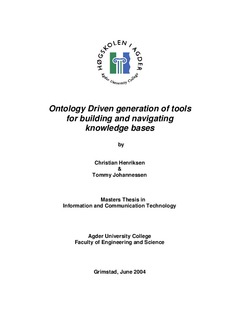| dc.contributor.author | Henriksen, Christian | |
| dc.contributor.author | Johanessen, Tommy | |
| dc.date.accessioned | 2007-06-29T13:30:38Z | |
| dc.date.issued | 2004 | |
| dc.identifier.uri | http://hdl.handle.net/11250/137242 | |
| dc.description | Masteroppgave i informasjons- og kommunikasjonsteknologi 2004 - Høgskolen i Agder, Grimstad | en |
| dc.description.abstract | Throughout the work of this thesis we have considered how to apply usability engineering to
multiple different projects using their own ontologies. Reviews on existing applications similar to
the Topic Map were made. The reviews gave us valuable information on what kind of usability
aspects and presentation techniques other model driven applications use.
Software projects are often built manually by planning and programming the application from
scratch. Needing more than one project with similarities, auto-generation can be a viable solution.
However, auto-generation does in general not provide sufficient usability to end products. In this
thesis we have investigated how to develop an application with auto-generation, including the
process of applying usability and utility engineering.
All projects, whether it is manually or auto generated, needs final customization to fit the
customer’s, and the end user’s demands. Therefore we had to find a way to improve the output
from the auto-generation, and if possible provide an understandable layer to make the final
implementation of usability and utility higher. A prototype showing how the auto-generation
application works was made.
The ontologies defined in this thesis use Topic Maps. These ontologies are then used to auto
generate the application. Developers should be able to customise the application, and therefore
customisable templates are generated along with the application. Using the Topic Map concepts
in these templates can confuse the developers. To make the templates more logical for the
developers, we decided to make a layer - a reflective API. This layer avoids technology specific
terms provided by the Topic Map engine. Methods generated are based on the ontologies, and are
therefore more logical for the developers. These methods make it easier to add functionality. The
templates are used to apply usability and utility to the applications.
During this thesis we have shown that generating a three layer model can benefit the developer
directly, and indirectly the end user since the developer then can spend more time with usability
engineering. | en |
| dc.format.extent | 931998 bytes | |
| dc.format.mimetype | application/pdf | |
| dc.language.iso | eng | en |
| dc.publisher | Høgskolen i Agder | |
| dc.publisher | Agder University College | |
| dc.subject.classification | IKT590 | |
| dc.title | Ontology driven generation of tools for building and navigating knowledge bases | en |
| dc.type | Master thesis | en |
| dc.subject.nsi | VDP::Matematikk og naturvitenskap: 400::Informasjons- og kommunikasjonsvitenskap: 420::Kunnskapsbaserte systemer: 425 | |
| dc.subject.nsi | VDP::Matematikk og naturvitenskap: 400::Informasjons- og kommunikasjonsvitenskap: 420::Systemutvikling og - arbeid: 426 | |
